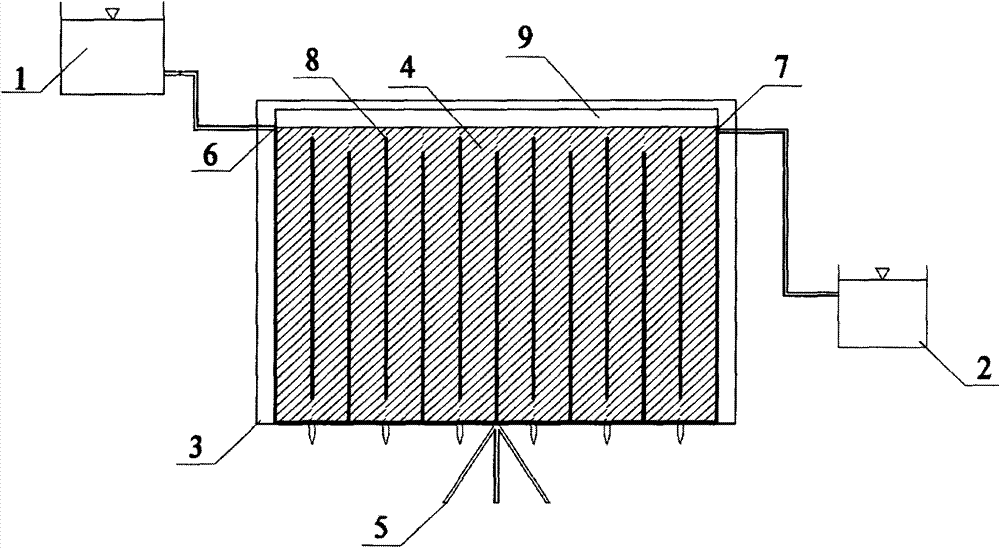Flat-plate solar photocatalysis water purifier for collected rainwater and drinking water
A solar and flat-panel technology, applied in the direction of light water/sewage treatment, etc., can solve the problem of heavy metals, achieve the effects of avoiding frostbite, convenient sampling and monitoring of water quality, and good photocatalytic performance
- Summary
- Abstract
- Description
- Claims
- Application Information
AI Technical Summary
Problems solved by technology
Method used
Image
Examples
Embodiment 1
[0032] Example 1 First, add ammonia water dropwise in distilled water to make the pH value 6; then add tetra-n-butyl titanate under magnetic stirring, stir until white precipitate is completely produced, and then add H with a mass concentration of 30% dropwise. 2 o 2 , and after stirring for 30 minutes, a uniformly mixed yellow peroxotitanic acid sol was obtained; secondly, the clean and dry geotextile was ultrasonically oscillated in the peroxotitanic acid sol, and after 5 minutes, it was sealed and heated to 30°C, and kept warm 6h; Finally, take out the geotextile, place it in a ventilated place for 3 days, and get TiO after repeated washing for 3 to 4 times. 2 / Geotextile supported photocatalyst.
[0033] Wherein the molar ratio of tetra-n-butyl phthalate, distilled water and hydrogen peroxide is 1:30:1.
Embodiment 2
[0034] Example 2 First, add ammonia water dropwise in distilled water to make the pH value 12; then add tetra-n-butyl titanate under magnetic stirring, stir until white precipitate is completely produced, and then add H with a mass concentration of 30% dropwise. 2 o 2 , and after stirring for 180 minutes, a uniformly mixed yellow peroxotitanic acid sol was obtained; secondly, the clean and dry geotextile was ultrasonically oscillated in the peroxotitanic acid sol, and after 30 minutes, it was sealed and heated to 95°C, and kept warm 36h; Finally, take out the geotextile, place it in a ventilated place for 7 days, and get TiO after repeated washing for 3-4 times. 2 / Geotextile supported photocatalyst.
[0035] Wherein the molar ratio of tetra-n-butyl phthalate, distilled water and hydrogen peroxide is 1:151:12.
Embodiment 3
[0036] Example 3 First, ammonia water was added dropwise in distilled water to make the pH value 9; then tetra-n-butyl titanate was added under magnetic stirring, and stirred until a white precipitate was completely formed, and then 30% H 2 o 2, and after stirring for 150 minutes, a uniformly mixed yellow peroxotitanic acid sol was obtained; secondly, the clean and dry geotextile was ultrasonically oscillated in the peroxotitanic acid sol, and after 20 minutes, it was sealed and heated to 65°C, and kept warm 21h; Finally, take out the geotextile, place it in a ventilated place for 5 days, and get TiO after repeated washing for 3 to 4 times. 2 / Geotextile supported photocatalyst.
[0037] Wherein the molar ratio of tetra-n-butyl phthalate, distilled water and hydrogen peroxide is 1:90:6.
PUM
 Login to View More
Login to View More Abstract
Description
Claims
Application Information
 Login to View More
Login to View More - R&D
- Intellectual Property
- Life Sciences
- Materials
- Tech Scout
- Unparalleled Data Quality
- Higher Quality Content
- 60% Fewer Hallucinations
Browse by: Latest US Patents, China's latest patents, Technical Efficacy Thesaurus, Application Domain, Technology Topic, Popular Technical Reports.
© 2025 PatSnap. All rights reserved.Legal|Privacy policy|Modern Slavery Act Transparency Statement|Sitemap|About US| Contact US: help@patsnap.com


